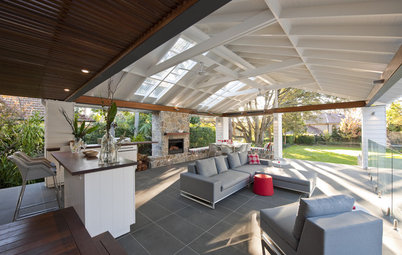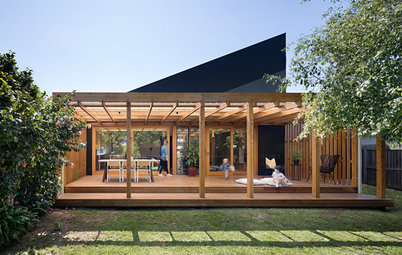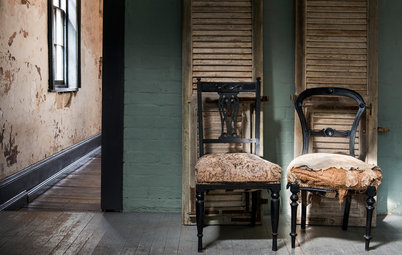Home Buyer Beware: How to Spot a Lemon
Get the heads up before buying a property with this troubleshooting guide to structural damage and pest problems
So, you’re about to purchase a dream home (or have already), and it looks like a sound investment … but as the old adage goes, ‘buyer beware’! The first thing you should do is hire an expert to look through the property, but in Australia, many houses and apartments are sold without the purchaser having had the home inspected for structural damage or pest problems. In fact, 80 per cent of Australian property transactions take place without such checks. In all cases, I highly recommend having an independent, reputable and experienced inspector come and help you diagnose the problem and suggest remedies. But even still, it’s good to know what they will be looking for and to try to identify the problems yourself. Here are the top six structural issues that can affect a house, how to identify them and what to do about the problem.
WHAT TO LOOK FOR: As you walk through a house, the most common way to detect this problem is to feel for movement under your feet as you walk – a ‘springy’ floor suggests problems down below. You may also notice glasses or crockery rattling in the sideboard or flowers shaking on the table when you walk through the home. My favourite, though, is the ‘marble test’. Put a marble on the floor (assuming it’s not carpeted) and if it runs off in one direction, you have an uneven floor. This often indicates deterioration in the stumps or floor framing. Check other areas of the house as well.
NEXT STEPS: If you are uncertain about your flooring, it’s time to get an inspector in to do a thorough check for you. Look for an inspector who is independent – in other words, not someone who also has a vested interest in selling you a solution. Make sure you ask for a report that includes: the state of the sub-floor area; specific detail of any problems; and recommendations as to how to rectify the problem. Be prepared for some form of building work such as re-stumping.
NEXT STEPS: If you are uncertain about your flooring, it’s time to get an inspector in to do a thorough check for you. Look for an inspector who is independent – in other words, not someone who also has a vested interest in selling you a solution. Make sure you ask for a report that includes: the state of the sub-floor area; specific detail of any problems; and recommendations as to how to rectify the problem. Be prepared for some form of building work such as re-stumping.
2. Timber rot
Timber rot occurs when timber is allowed to become damp and remain that way for a long period.
THE PROBLEM: Timber rot is common where timber meets the ground – for example, in timber stumps (as noted earlier), decking, pergolas and fencing. Timber rot will erode the structure of timbers and is encouraged by damp conditions under the house and around timber in contact with the ground.
WHAT TO LOOK FOR: Timber rot is slow to move, but nonetheless damaging. Signs of timber rot include soft or spongy timber. If you poke a screwdriver or similar into the timber, it comes away in shreds or pieces. This will be particularly common underground, so you might have to dig a little.
NEXT STEPS: To discourage timber rot, ensure downpipes, hoses and plumbing pipes are not leaking. Don’t mound garden beds or mulch up against the house, particularly against timber lining. Don’t store timber underneath or against your house, either. Rotted timber must be replaced – this can mean the entire timber element such as a pergola post. A good builder can do this for you.
Timber rot occurs when timber is allowed to become damp and remain that way for a long period.
THE PROBLEM: Timber rot is common where timber meets the ground – for example, in timber stumps (as noted earlier), decking, pergolas and fencing. Timber rot will erode the structure of timbers and is encouraged by damp conditions under the house and around timber in contact with the ground.
WHAT TO LOOK FOR: Timber rot is slow to move, but nonetheless damaging. Signs of timber rot include soft or spongy timber. If you poke a screwdriver or similar into the timber, it comes away in shreds or pieces. This will be particularly common underground, so you might have to dig a little.
NEXT STEPS: To discourage timber rot, ensure downpipes, hoses and plumbing pipes are not leaking. Don’t mound garden beds or mulch up against the house, particularly against timber lining. Don’t store timber underneath or against your house, either. Rotted timber must be replaced – this can mean the entire timber element such as a pergola post. A good builder can do this for you.
3. Termite damage
Termites feed on a wide variety of plant material, unfortunately including the timber our houses are commonly built from. They are quite common throughout Australia, although worse in northern regions (Queenslanders will know what I mean). Tasmania, though, is blessed with no issues from termites, largely due to isolation and a relatively cold climate.
THE PROBLEM: Termites love damp conditions and their attack can severely damage the timber structures of your home if left unchecked.
WHAT TO LOOK FOR: Termites can sometimes be identified by the mud tubes they build from the ground up to the timber structure of the house. If they have started eating away your timber structure, you might not notice until someone puts their foot through the floor!
NEXT STEPS: You’ll discourage termites if you deal with any dampness, including timber rot. If you do discover termites, don’t provoke them – they will only move on to another area. Termites can move very quickly, so if you have doubts, arrange an inspection by a registered pest inspector.
Termites feed on a wide variety of plant material, unfortunately including the timber our houses are commonly built from. They are quite common throughout Australia, although worse in northern regions (Queenslanders will know what I mean). Tasmania, though, is blessed with no issues from termites, largely due to isolation and a relatively cold climate.
THE PROBLEM: Termites love damp conditions and their attack can severely damage the timber structures of your home if left unchecked.
WHAT TO LOOK FOR: Termites can sometimes be identified by the mud tubes they build from the ground up to the timber structure of the house. If they have started eating away your timber structure, you might not notice until someone puts their foot through the floor!
NEXT STEPS: You’ll discourage termites if you deal with any dampness, including timber rot. If you do discover termites, don’t provoke them – they will only move on to another area. Termites can move very quickly, so if you have doubts, arrange an inspection by a registered pest inspector.
4. Illegal building work
In order to know that your new building project is as well-built as the graceful carport pictured here, minimum building standards must be met. Nobody wants to take out a wall or build a deck, only to put family and friends in danger because they didn’t understand the minimum building structural requirements.
The rise in popularity of home renovation TV has done nothing to discourage Aussie ‘can-do’ homeowners from attempting to undertake their own DIY renovations. However, it is generally illegal to undertake any structural work on your property without a proper permit in Australia. This includes building a deck or carport. The Building Code of Australia sets nationally consistent, minimum safety standards for building.
THE PROBLEM: Common illegal works can include the removal of interior load-bearing walls that cause sagging roofs and ceilings the addition of rooms in roof spaces without appropriate support structures; and tacked-on additions that do not look like part of the original home.
WHAT TO LOOK FOR: The challenge here is to identify illegal building work – something most of us can’t do. Often illegal building is covered up with quick makeovers or painting, etc. Always ask to see relevant permits for recent building work or anything that doesn’t appear to be correct. Your local council can help with this information if the vendor or agent can’t.
NEXT STEPS: If you suspect illegal building work, have a reputable inspector undertake an inspection for you to verify the issue first, including compliance with building regulations. In some cases, your local council or building surveyor may require you to demolish the work, or you may have to undertake additional building works to bring things into line with building regulations.
In order to know that your new building project is as well-built as the graceful carport pictured here, minimum building standards must be met. Nobody wants to take out a wall or build a deck, only to put family and friends in danger because they didn’t understand the minimum building structural requirements.
The rise in popularity of home renovation TV has done nothing to discourage Aussie ‘can-do’ homeowners from attempting to undertake their own DIY renovations. However, it is generally illegal to undertake any structural work on your property without a proper permit in Australia. This includes building a deck or carport. The Building Code of Australia sets nationally consistent, minimum safety standards for building.
THE PROBLEM: Common illegal works can include the removal of interior load-bearing walls that cause sagging roofs and ceilings the addition of rooms in roof spaces without appropriate support structures; and tacked-on additions that do not look like part of the original home.
WHAT TO LOOK FOR: The challenge here is to identify illegal building work – something most of us can’t do. Often illegal building is covered up with quick makeovers or painting, etc. Always ask to see relevant permits for recent building work or anything that doesn’t appear to be correct. Your local council can help with this information if the vendor or agent can’t.
NEXT STEPS: If you suspect illegal building work, have a reputable inspector undertake an inspection for you to verify the issue first, including compliance with building regulations. In some cases, your local council or building surveyor may require you to demolish the work, or you may have to undertake additional building works to bring things into line with building regulations.
5. Damp and moisture
Damp and moisture can cause a range of structural problems as discussed above, including timber rot and the encouragement of damaging termite activity, but dampness in the foundations of a building (the soil around the building footings) can also cause cracking in walls and, in extreme cases, movement in concrete slabs that can impact an entire house.
THE PROBLEM: Prolonged periods of drought (think Australia from the mid-1990s to mid-2000s) can cause persistent drying and shrinkage of soil, which can move building footings and cause wall cracks. Similarly, prolonged dampness, caused by excessive watering, leaking plumbing or downpipes, can lead to the rapid swelling of soils, which can also lead to cracking. Both these situations are more common in clay soil types that are more reactive to moisture.
WHAT TO LOOK FOR: If a crack appears overnight in your previously intact brick house, don’t panic. It is not the first step in the total disintegration of the whole building. All buildings move a little, and most cracks require cosmetic treatment only. The majority are not indications of grave structural damage. Remedies can be as simple as watering the garden a bit more or less, or just waiting for the season to change. However, it can be valuable, if only for peace of mind, to be able to recognise and evaluate the type of cracks. You will then have some logical basis for deciding which method of correction will be appropriate.
Cracking can be vertical, horizontal, cogged, stepped or a combination. The form it takes is sometimes a clear indication of the problem.
NEXT STEPS: Too much moisture can usually be addressed by removing the source of the problem, such as repairing the pipes, or ceasing watering the garden. When there is too little moisture, the resultant problem can usually be addressed by adding moisture (careful watering). Both options should be taken in small steps with a careful observation in between treatments to assess any impacts.
Damp and moisture can cause a range of structural problems as discussed above, including timber rot and the encouragement of damaging termite activity, but dampness in the foundations of a building (the soil around the building footings) can also cause cracking in walls and, in extreme cases, movement in concrete slabs that can impact an entire house.
THE PROBLEM: Prolonged periods of drought (think Australia from the mid-1990s to mid-2000s) can cause persistent drying and shrinkage of soil, which can move building footings and cause wall cracks. Similarly, prolonged dampness, caused by excessive watering, leaking plumbing or downpipes, can lead to the rapid swelling of soils, which can also lead to cracking. Both these situations are more common in clay soil types that are more reactive to moisture.
WHAT TO LOOK FOR: If a crack appears overnight in your previously intact brick house, don’t panic. It is not the first step in the total disintegration of the whole building. All buildings move a little, and most cracks require cosmetic treatment only. The majority are not indications of grave structural damage. Remedies can be as simple as watering the garden a bit more or less, or just waiting for the season to change. However, it can be valuable, if only for peace of mind, to be able to recognise and evaluate the type of cracks. You will then have some logical basis for deciding which method of correction will be appropriate.
Cracking can be vertical, horizontal, cogged, stepped or a combination. The form it takes is sometimes a clear indication of the problem.
NEXT STEPS: Too much moisture can usually be addressed by removing the source of the problem, such as repairing the pipes, or ceasing watering the garden. When there is too little moisture, the resultant problem can usually be addressed by adding moisture (careful watering). Both options should be taken in small steps with a careful observation in between treatments to assess any impacts.
6. Deck construction
The humble deck has taken on renewed interest and significance over the past 10 years, particularly in the guise of an ‘outdoor room’. Australians are increasingly enjoying outdoor living and entertainment with family and friends. However, building a deck requires a proper understanding of construction techniques and regulations, including the Building Code of Australia and any local requirements, such as the cyclone wind ratings in northern Australia.
Decks are also commonly (although not always) built from timber. Any timber exposed to the elements must either be carefully selected for the task or be regularly maintained. For example, use paint or oil finishes to stop the moisture from rain splitting the wooden beams. This applies all over a house, not just the deck – however, a rotting or cracked weatherboard lining probably won’t hurt you.
THE PROBLEM: Every year there are tragic news stories of decks or balconies collapsing with subsequent injuries. A deck will often have similar structural load requirements as the floor of a house – it has to hold up a number of people, furniture, parties and withstand wild weather, rain storms, wind loads and other forces. Building a deck then is not simply an exercise in heading to your local timber merchant and picking out the decking timber. While building a deck is not beyond some DIY practitioners, it requires knowledge, skill and permits!
The humble deck has taken on renewed interest and significance over the past 10 years, particularly in the guise of an ‘outdoor room’. Australians are increasingly enjoying outdoor living and entertainment with family and friends. However, building a deck requires a proper understanding of construction techniques and regulations, including the Building Code of Australia and any local requirements, such as the cyclone wind ratings in northern Australia.
Decks are also commonly (although not always) built from timber. Any timber exposed to the elements must either be carefully selected for the task or be regularly maintained. For example, use paint or oil finishes to stop the moisture from rain splitting the wooden beams. This applies all over a house, not just the deck – however, a rotting or cracked weatherboard lining probably won’t hurt you.
THE PROBLEM: Every year there are tragic news stories of decks or balconies collapsing with subsequent injuries. A deck will often have similar structural load requirements as the floor of a house – it has to hold up a number of people, furniture, parties and withstand wild weather, rain storms, wind loads and other forces. Building a deck then is not simply an exercise in heading to your local timber merchant and picking out the decking timber. While building a deck is not beyond some DIY practitioners, it requires knowledge, skill and permits!
WHAT TO LOOK FOR: Deck problems can often be ascertained in a similar manner to the floor-framing problems discussed earlier. Movement or ‘springy-ness’ is a sure sign of problems below. Loose, split or broken deck boards are a sign that either the deck hasn’t been well maintained or hasn’t been built properly. Look also for signs of timber rot or damage to the deck structure, such as split or deteriorated timber framing and rusted bolts.
Timbers are rated into four categories for outdoor use – Class 1 is the most durable; Class 4 is the least durable. For example, ironbark is a Class 1 timber – very durable. Chemically treated timbers are also suitable for outdoor use.
NEXT STEPS: Seek the advice of an architect or your timber supplier as to the best timbers available in your area for building a deck. Use the services of a reputable builder to construct your deck, and obtain all the correct permits and approvals.
Timbers are rated into four categories for outdoor use – Class 1 is the most durable; Class 4 is the least durable. For example, ironbark is a Class 1 timber – very durable. Chemically treated timbers are also suitable for outdoor use.
NEXT STEPS: Seek the advice of an architect or your timber supplier as to the best timbers available in your area for building a deck. Use the services of a reputable builder to construct your deck, and obtain all the correct permits and approvals.
As I said at the beginning, any of these problems would benefit from an inspection by an expert to help you understand the nature and extent of the problem. None of them is necessarily a deal-breaker for the purchase of a house, or indeed to continue living in a house, but they do require immediate attention. So be sure that your dream home doesn’t turn into a nightmare. With just a few simple calls and checks, you’ll be as safe as houses.
TELL US
Have you had a structural problem or pest infestation that attacked the framework of your home? If so, what did you do about it? Let us know in the Comments section.
MORE
15 Things to Ask Before Buying a House in Australia
7 Important Questions to Ask Builders
How to Build the Best Deck to Suit Your Lifestyle
The Construction Process: 7 Must-Dos Before You Start to Build
TELL US
Have you had a structural problem or pest infestation that attacked the framework of your home? If so, what did you do about it? Let us know in the Comments section.
MORE
15 Things to Ask Before Buying a House in Australia
7 Important Questions to Ask Builders
How to Build the Best Deck to Suit Your Lifestyle
The Construction Process: 7 Must-Dos Before You Start to Build





















In Australia, the majority of homes have been built on a ‘suspended floor’, generally timber framed, that is, up until the 1980s when concrete slabs became more common. A suspended floor generally consisted of timber stumps sunk into the ground, with timber bearers and joists crisscrossing the stumps, creating a stable platform for the flooring and remainder of the house.
THE PROBLEM: The timber stumps are susceptible to rotting from exposure to moisture and damage by timber pests like termites, sometimes known as white ants. The damage could be contained in one area of the floor, or it could affect a large portion of the house, giving the floor a slope in one direction. In extreme cases, the doors and windows no longer open or close properly due to movement in the frames brought about by stumping problems. Fortunately, modern suspended floors now use concrete stumps, but if you are purchasing an old home, there could be an issue with the frame.